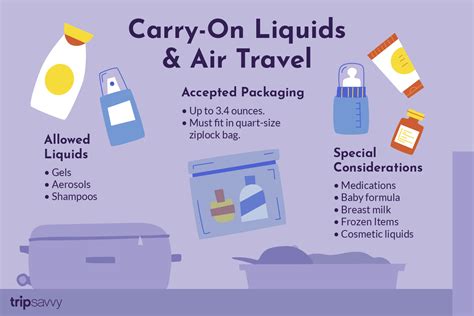Air Travel Liquids Restrictions

Introduction to Air Travel Liquids Restrictions
When it comes to air travel, there are various restrictions and guidelines that passengers must adhere to for safety and security reasons. One of the most important sets of rules pertains to the transportation of liquids, gels, and aerosols in carry-on bags. These regulations, often referred to as the 3-1-1 liquids rule, have been in place for many years and are designed to prevent potential threats to the safety of flights. Understanding these rules is crucial for a smooth and hassle-free travel experience.
Understanding the 3-1-1 Liquids Rule
The 3-1-1 liquids rule is a straightforward guideline that helps passengers pack their carry-on bags appropriately. The rule states that: - 3: Liquids, gels, and aerosols must be in containers of 3.4 ounces (100 milliliters) or less. - 1: These containers must be placed in a 1-quart (1-liter) clear, zip-top plastic bag. - 1: Only 1 zip-top plastic bag is allowed per passenger.
This rule applies to all liquids, gels, and aerosols, including but not limited to:
- Shampoos and conditioners
- Toothpaste
- Deodorant
- Perfumes and colognes
- Cosmetic creams
- Contact lens solution
- Medications in liquid form (though these may have special considerations, discussed later)
Exceptions to the Rule
While the 3-1-1 rule applies to most liquids, gels, and aerosols, there are some exceptions and special considerations: - Medications: Essential medications, including those in liquid form, are allowed in reasonable quantities exceeding 3.4 ounces. However, these must be declared and may be subject to additional screening. It’s advisable to carry a prescription or a letter from your doctor to facilitate the screening process. - Baby Formula, Breast Milk, and Juice: These are allowed in reasonable quantities and do not need to fit within a zip-top bag. However, they may be subject to additional screening. - Duty-Free Items: Liquids, gels, and aerosols purchased in duty-free shops are allowed in reasonable quantities but must be sealed in a tamper-evident bag and accompanied by a receipt. These items must also be carried in a transparent, resealable bag for screening.
Preparation is Key
To avoid any issues during security screening, it’s crucial to prepare your carry-on bag accordingly: - Pack smart: Ensure all liquids, gels, and aerosols are in containers of 3.4 ounces or less and fit within a 1-quart zip-top bag. - Declare items: If you have any items that are exceptions to the rule (like medications or baby formula), be prepared to declare them and provide necessary documentation. - Wear easy-to-remove shoes: And avoid wearing anything with metal to speed through security checkpoints. - Consider checking bags: For items that don’t meet the 3-1-1 rule, consider packing them in checked luggage to avoid issues.
Notes on Security Screening
🚨 Note: Security protocols can vary between airports and countries, so it’s always a good idea to check with your airline and the airport you’re flying from for the most current information.
Summary of Key Points
Air travel liquids restrictions are in place to ensure the safety of all passengers. By understanding and complying with the 3-1-1 liquids rule, passengers can navigate security checks more efficiently. It’s also important to be aware of the exceptions and to prepare accordingly, whether it’s for medications, baby formula, or duty-free items.
In summary, the key to a smooth travel experience is being informed and prepared. Knowing what you can and cannot carry in your carry-on, and how to properly pack and declare items, will help minimize delays and make your journey more enjoyable.
What is the 3-1-1 liquids rule in air travel?
+
The 3-1-1 liquids rule states that liquids, gels, and aerosols in containers of 3.4 ounces or less must be placed in a 1-quart clear, zip-top plastic bag, with only one bag allowed per passenger.
Are there any exceptions to the 3-1-1 rule?
+
Yes, there are exceptions for medications, baby formula, breast milk, and juice, which can be carried in reasonable quantities and do not need to fit within the zip-top bag, though they may require additional screening.
How should I prepare my carry-on bag for security screening?
+
Ensure all liquids, gels, and aerosols are in containers of 3.4 ounces or less, fit within a 1-quart zip-top bag, and be prepared to declare any exceptions, such as medications or baby formula, providing necessary documentation.